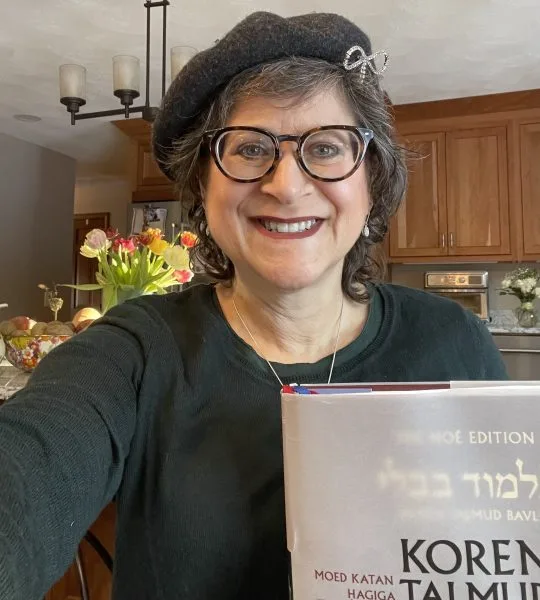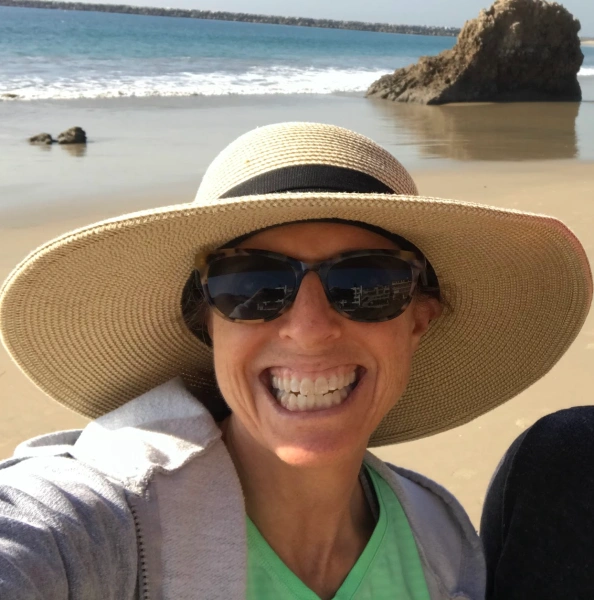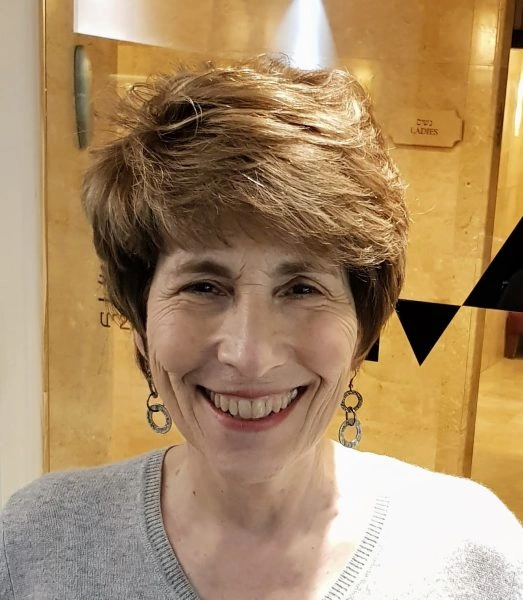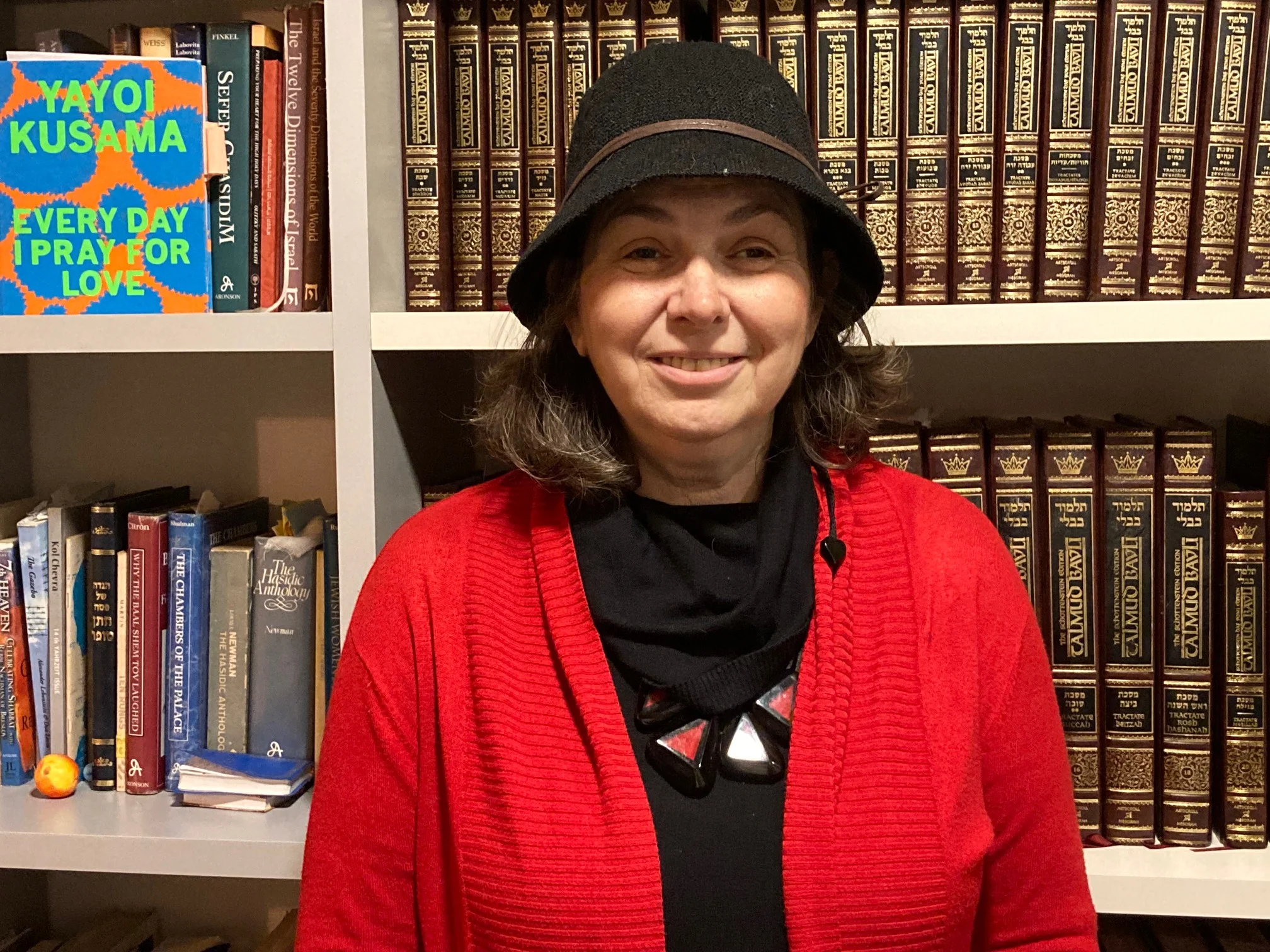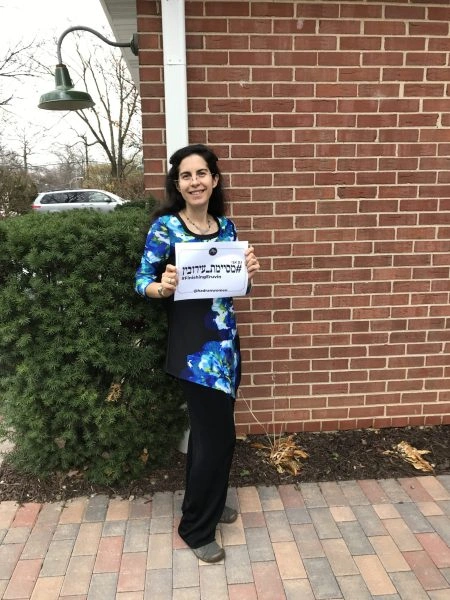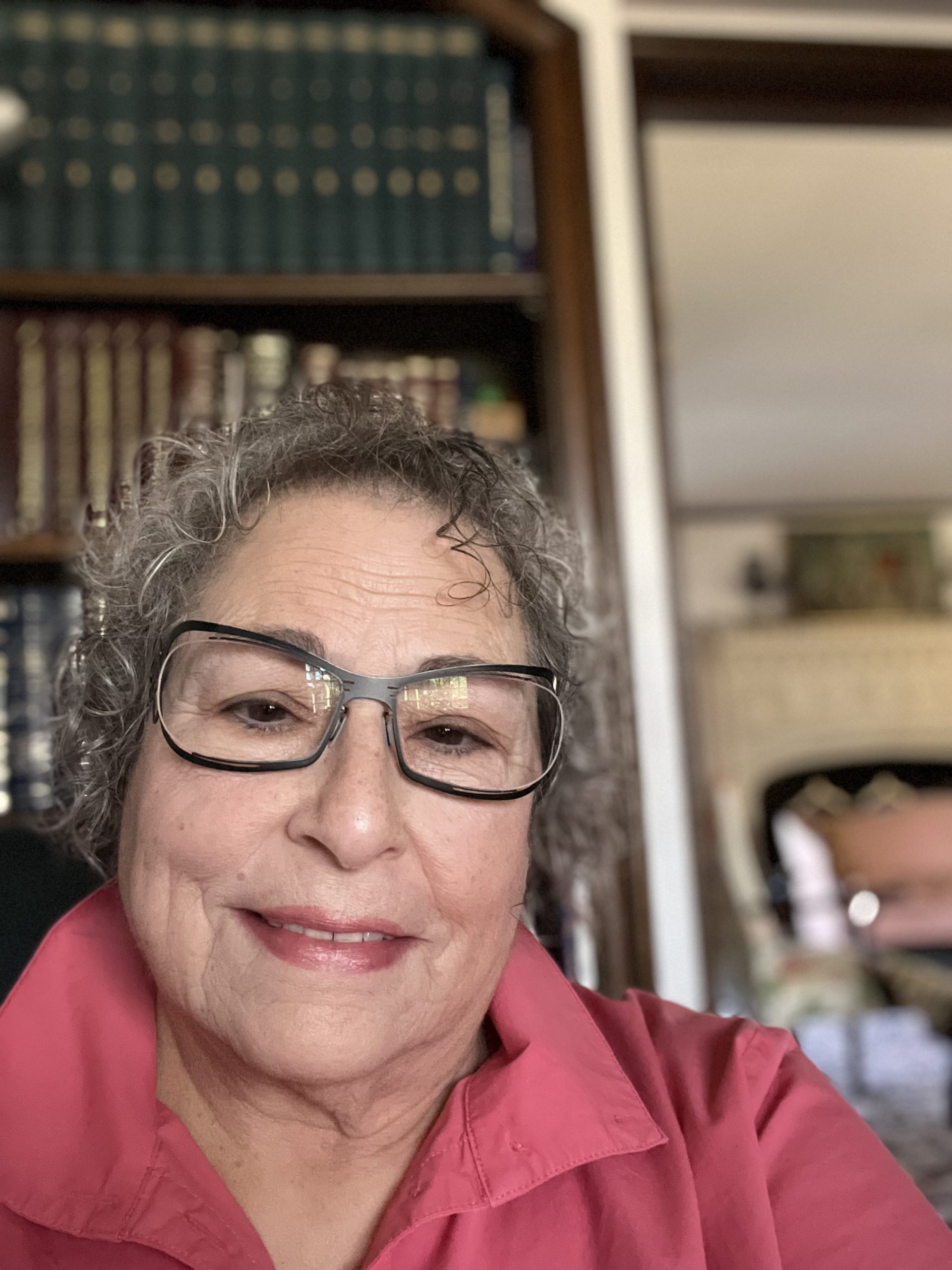The mishna lists cases in which truma fell into items that were chullin and forbade the mixture. Then part of that mixture combined with other chullin. How does one calculate laws of nullification? Is there a way to use drawn water in a mikveh? How should the ashes be mixed with water to the purification waters – water first or ashes first? A field in which there is a dead body – if one plows, should one be concerned for the surrounding fields? Is substitution on a substituted animal effective? Can an offspring of a sanctified animal effect substitution? The gemara explains the debates surrounding these issues.
Want to dedicate learning? Get started here:
Today’s daily daf tools:
Delve Deeper
Broaden your understanding of the topics on this daf with classes and podcasts from top women Talmud scholars.
New to Talmud?
Check out our resources designed to help you navigate a page of Talmud – and study at the pace, level and style that fits you.
The Hadran Women’s Tapestry
Meet the diverse women learning Gemara at Hadran and hear their stories.
Temurah 12
אֲמַר לֵיהּ: מִי קָרֵינָא בֵּיהּ ״כִּי יִרְחַק מִמְּךָ הַמָּקוֹם… וְזָבַחְתָּ״?
Rav Yosef said to Abaye: Slaughtering a pregnant peace offering containing a non-sacred fetus is not subject to the prohibition against slaughtering non-sacred animals in the Temple courtyard. Do we read the verse: “If the place which the Lord your God shall choose to put His name there be too far from you, then you shall slaughter of your herd and of your flock” (Deuteronomy 12:21), as applying to such a case? This verse prohibits the slaughter of non-sacred animals in the Temple, but only those that could be slaughtered elsewhere. But here, he had no choice but to slaughter the pregnant mother in the Temple, since it was a peace offering.
בָּעֵי מִינֵּיהּ אַבָּיֵי מֵרַב יוֹסֵף: הִיא חוּלִּין וּוְלָדָהּ שְׁלָמִים, וּשְׁחָטָהּ בְּחוּץ — מַהוּ? מִי מִחַיַּיב עֲלֵיהּ מִשּׁוּם שְׁחוּטֵי חוּץ, אוֹ לָא?
Abaye posed the opposite dilemma to Rav Yosef: According to the opinion of Rabbi Yoḥanan that fetuses can be consecrated, if one consecrated the fetus, but not its mother, as a peace offering, such that it, the mother, is non-sacred, and its offspring is a peace offering, and he slaughtered it outside the Temple courtyard as a non-sacred animal, what is the halakha? Is one liable for it due to the prohibition against slaughtering offerings outside the Temple courtyard, or not?
אֲמַר לֵיהּ: מִי קָרֵינָא בֵּיהּ ״וֶהֱבִיאָם לַה׳״?
Rav Yosef said to Abaye: Do we read the verse: “That they may bring them to the Lord” (Leviticus 17:5), as applying to this case? The full passage reads: “Any man of the house of Israel who shall slaughter a bull, or a lamb, or a goat…and has not brought it to the entrance to the Tent of Meeting…that man shall be cut off from among his people. To the end that the children of Israel may bring their sacrifices, which they sacrifice in the open field, even that they may bring them to the Lord, to the door of the Tent of Meeting” (Leviticus 17:3–5). The passage indicates that the prohibition against slaughtering offerings outside the Temple applies only to those offerings that are fit to be slaughtered inside. But this fetus is not fit to be slaughtered at all until it is born.
לִישָּׁנָא אַחֲרִינָא, אֲמַר לֵיהּ: רָאוּי לְפֶתַח אֹהֶל מוֹעֵד חַיָּיבִין עָלָיו בַּחוּץ.
The Gemara cites another version of this answer. Rav Yosef said to Abaye: The verse states: “And has not brought it to the entrance to the Tent of Meeting.” This teaches that one is liable for slaughtering an offering outside the Temple only if it is fit to come through the entrance to the Tent of Meeting, i.e., to be sacrificed in the Temple. This fetus is not yet fit.
מַתְנִי׳ אֵין הַמְדוּמָּע מְדַמֵּעַ, אֶלָּא לְפִי חֶשְׁבּוֹן.
MISHNA: If teruma, the portion of the produce designated for the priest, was intermingled with non-sacred produce, and it is impossible to distinguish between them, if the ratio of non-sacred produce to teruma was less than one hundred to one, the teruma is not nullified and all the produce is forbidden to those for whom teruma is forbidden. If the mixture was then intermingled with other non-sacred produce, that mixture renders it a mixture of teruma only according to the calculation of the percentage of the original teruma produce in the entire mixture.
וְאֵין הַמְחוּמָּץ מְחַמֵּץ אֶלָּא לְפִי חֶשְׁבּוֹן, וְאֵין הַמַּיִם שְׁאוּבִין פּוֹסְלִין אֶת הַמִּקְוֶה אֶלָּא לְפִי חֶשְׁבּוֹן.
And dough that was leavened with a teruma leavening agent is forbidden to those for whom teruma is forbidden even if the ratio between the non-sacred and the teruma is greater than one hundred to one. If a portion of that dough was intermingled with non-sacred dough, it leavens only according to the calculation of the percentage of the original leavening agent in the entire dough, and the second dough is forbidden only if the quantity of the original teruma leavening agent inside it is sufficient to leaven it. And if three log of drawn water were poured into a ritual bath with less than forty se’a to complete the requisite forty se’a, the ritual bath is invalidated. But drawn water invalidates the ritual bath only according to calculation, as explained in the Gemara.
וְאֵין מֵי חַטָּאת, עוֹשִׂין מֵי חַטָּאת אֶלָּא עִם מַתַּן אֵפֶר, וְאֵין בֵּית הַפְּרָס עוֹשִׂין בֵּית הַפְּרָס, וְאֵין תְּרוּמָה אַחַר תְּרוּמָה.
And the water of purification of the red heifer becomes water of purification only with the placement of the ashes into the water, but not by placement of water onto the ashes. And one beit haperas does not create another beit haperas. The Sages decreed ritual impurity on a field in which a grave was plowed, scattering the bones throughout the field. This field is called a beit haperas. That impurity extends to the area of one hundred cubits surrounding the grave. Nevertheless, they did not decree impurity on the second field if one plowed from that field into another field. And there is no teruma after teruma. Once one designates produce from his crop as teruma, if he then designates additional produce from that crop as teruma, it is not teruma.
וְאֵין תְּמוּרָה עוֹשָׂה תְּמוּרָה, וְלֹא הַוָּלָד עוֹשֶׂה תְּמוּרָה. רַבִּי יְהוּדָה אוֹמֵר: הַוָּלָד עוֹשֶׂה תְּמוּרָה. אָמְרוּ לוֹ: הֶקְדֵּשׁ עוֹשֶׂה תְּמוּרָה, וְאֵין הַוָּלָד עוֹשֶׂה תְּמוּרָה.
And a substitute animal that was consecrated when it was substituted for a consecrated animal does not render a non-sacred animal exchanged for it a substitute; rather, it remains non-sacred. And the offspring born of a consecrated animal that was not consecrated itself does not render a non-sacred animal exchanged for it a substitute. Rabbi Yehuda says: The offspring renders a non-sacred animal exchanged for it a substitute. The Sages said to him: A consecrated animal renders a non-sacred animal exchanged for it a substitute, but the offspring does not render a non-sacred animal exchanged for it a substitute.
גְּמָ׳ מַאן תַּנָּא? אָמַר רַבִּי חִיָּיא בַּר אַבָּא אָמַר רַבִּי יוֹחָנָן: דְּלָא כְּרַבִּי אֱלִיעֶזֶר.
GEMARA: The mishna teaches that if a mixture of teruma produce and non-sacred produce was intermingled with other non-sacred produce, that mixture is prohibited only according to the calculation of the percentage of the original teruma produce in the entire mixture. The Gemara asks: Who is the tanna whose opinion is reflected in this ruling? Rabbi Ḥiyya bar Abba said that Rabbi Yoḥanan said: This ruling is not in accordance with the opinion of Rabbi Eliezer.
דִּתְנַן: סְאָה שֶׁל תְּרוּמָה שֶׁנָּפְלָה לְפָחוֹת מִמֵּאָה חוּלִּין, וְנִדְמְעוּ, וְנָפַל מִן הַמְדוּמָּע לְמָקוֹם אַחֵר, רַבִּי אֱלִיעֶזֶר אוֹמֵר: מְדַמֵּעַ כִּתְרוּמָה וַדַּאי (שֶׁאֲנִי אוֹמֵר: סְאָה שֶׁנָּפְלָה הִיא שֶׁעָלְתָה).
As we learned in a mishna (Terumot 5:6): If a se’a of teruma fell into less than one hundred se’a of non-sacred produce and thereby caused it to become a prohibited mixture, since the amount of teruma is too great to be nullified by the non-sacred produce, and a se’a from the mixture subsequently fell into a different place with non-sacred produce, Rabbi Eliezer says: The se’a from the original mixture renders it a prohibited mixture as definite teruma would, in the same ratio, since I say: It is possible that the same se’a of teruma that fell into the first mixture was not mixed evenly throughout, and it all came out of it intact and fell into the second mixture. Therefore, it requires nullification as if it were unadulterated teruma.
וַחֲכָמִים אוֹמְרִים: אֵינָהּ מְדַמַּעַת אֶלָּא לְפִי חֶשְׁבּוֹן שֶׁבָּהּ.
And the Rabbis say: The se’a from the original prohibited mixture renders the derivative mixture prohibited only according to the calculation of actual teruma in the entire mixture, calculated as if the teruma were evenly distributed throughout the first mixture. The mishna evidently follows the opinion of the Rabbis.
וְאֵין הַמְחוּמָּץ מְחַמֵּץ כּוּ׳. אָמַר רַבִּי אַבָּא אָמַר רַבִּי יוֹחָנָן: מַתְנִיתִין דְּלָא כְּרַבִּי אֱלִיעֶזֶר.
§ The mishna teaches: And if a portion of dough that was leavened with a teruma leavening agent was intermingled with non-sacred dough, it leavens only according to the calculation. Rabbi Abba said that Rabbi Yoḥanan said: The mishna is not in accordance with the opinion of Rabbi Eliezer.
דִּתְנַן: שְׂאוֹר שֶׁל חוּלִּין וְשֶׁל תְּרוּמָה שֶׁנָּפְלוּ לְתוֹךְ הָעִיסָּה, וְלֹא בָּזֶה כְּדֵי לְהַחְמִיץ, וְלֹא בָּזֶה כְּדֵי לְהַחְמִיץ, וְנִצְטָרְפוּ וְחִימְּצוּ. רַבִּי אֱלִיעֶזֶר אוֹמֵר: אַחַר אַחֲרוֹן אֲנִי בָּא, וַחֲכָמִים אוֹמְרִים: בֵּין שֶׁנָּפַל אִיסּוּר לְכַתְּחִילָּה וּבֵין שֶׁנָּפַל אִיסּוּר בַּסּוֹף, לְעוֹלָם אֵין אָסוּר עַד שֶׁיְּהֵא בּוֹ כְּדֵי לְהַחְמִיץ.
As we learned in a mishna (Orla 2:11): In a case of non-sacred leaven and leaven of teruma that fell together into a non-sacred batch of dough, and this one alone was not potent enough to cause the dough to become leavened, and that one alone was not potent enough to cause the dough to become leavened, and they combined and caused the dough to become leavened, Rabbi Eliezer says: I follow the final element to fall into the dough. If the teruma fell in last, the dough is prohibited to non-priests. And the Rabbis say: Whether the forbidden item, i.e., the teruma, fell in first or the forbidden item fell in last, it is prohibited only if there is enough of the prohibited leaven itself to cause the dough to leaven.
וְאֵין הַמַּיִם שְׁאוּבִין פּוֹסְלִין אֶת הַמִּקְוֶה. מַאן תָּנָא? אָמַר רַבִּי חִיָּיא בַּר אַבָּא אָמַר רַבִּי יוֹחָנָן: רַבִּי אֱלִיעֶזֶר בֶּן יַעֲקֹב הִיא, דִּתְנַן: רַבִּי אֱלִיעֶזֶר בֶּן יַעֲקֹב אוֹמֵר: מִקְוֶה שֶׁיֵּשׁ בּוֹ עֶשְׂרִים וְאַחַת סְאָה מֵי גְשָׁמִים, מְמַלֵּא בַּכָּתֵף תְּשַׁע עֶשְׂרֵה סְאָה, וּפוֹתְקָן לַמִּקְוֶה,
§ The mishna further teaches: And drawn water invalidates the ritual bath only according to calculation. The Gemara asks: Who is the tanna whose opinion is reflected in this ruling? Rabbi Ḥiyya bar Abba says that Rabbi Yoḥanan says: It is Rabbi Eliezer ben Ya’akov, as we learned in a baraita (Tosefta, Mikvaot 4:3) that Rabbi Eliezer ben Ya’akov says: If a ritual bath contains twenty-one se’a of rainwater, the majority of a valid ritual bath of forty se’a, what can one do to render it valid? One fills drawn water in a bucket carried on the shoulder in the amount of nineteen se’a, and with it fills a pit adjacent to the ritual bath, and one lets the water flow [ufotekan] through a passage from the pit into the ritual bath,
וְהֵן טְהוֹרִין, שֶׁהַשְּׁאִיבָה מְטַהֶרֶת בִּרְבִיָּיה וּבְהַמְשָׁכָה.
and in this manner all forty se’a are ritually pure. The reason is that drawn water is purified by a majority of fit water that was already present in the ritual bath and by the drawn water flowing into the ritual bath. This is the meaning of the mishna’s statement that drawn water invalidates the ritual bath only according to calculation: One calculates the amount of drawn water that flowed into the ritual bath, as the ritual bath is invalid only if most of the forty se’a is of that drawn water.
מִכְּלָל דְּרַבָּנַן סָבְרִי דְּבִרְבִיָּיה וּבְהַמְשָׁכָה לָא? אֶלָּא דְּכִי אֲתָא רָבִין אָמַר רַבִּי יוֹחָנָן: שְׁאוּבָה שֶׁהִמְשִׁיכוּהָ כּוּלָּהּ — טְהוֹרָה. מַנִּי? לָא רַבָּנַן וְלָא רַבִּי אֱלִיעֶזֶר!
The Gemara asks: If this is the opinion of Rabbi Eliezer ben Ya’akov alone, one must conclude by inference that the Rabbis hold that the ritual bath is not fit even by a majority of fit water and by the flowing of the drawn water. But if so, consider that which Ravin said when he came from Eretz Yisrael to Babylonia, namely, that Rabbi Yoḥanan said: A ritual bath that consists in its entirety of drawn water that one made flow into it is pure. In accordance with whose opinion is this? It is not in accordance with the opinion of the Rabbis, who maintain that drawn water invalidates the ritual bath even if it flowed into it, and it is not in accordance with the opinion of Rabbi Eliezer ben Ya’akov, who holds that drawn water invalidates the ritual bath if it constitutes a majority of the forty se’a.
אֶלָּא אָמַר רַבָּה: לְפִי חֶשְׁבּוֹן כֵּלִים, וְיוֹסֵף בֶּן חוֹנִי הִיא.
Rather, Rabba says: The mishna’s ruling, that drawn water invalidates the ritual bath only according to calculation, is not referring to drawn water that flowed. Instead, it means according to the calculation of the number of vessels from which the drawn water was directly poured into the ritual bath, and this is in accordance with the opinion of Yosef ben Ḥoni.
דְּתַנְיָא: שְׁלֹשֶׁת לוּגִּין מַיִם שְׁאוּבִין שֶׁנָּפְלוּ לַמַּיִם, בִּשְׁנַיִם וּשְׁלֹשָׁה כֵּלִים, וַאֲפִילּוּ בְּאַרְבָּעָה וַחֲמִשָּׁה כֵּלִים — פּוֹסְלִים אֶת הַמִּקְוֶה. יוֹסֵף בֶּן חוֹנִי אוֹמֵר: בִּשְׁנַיִם וּשְׁלֹשָׁה כֵּלִים (פוסל) [פּוֹסְלִין] אֶת הַמִּקְוֶה, בְּאַרְבָּעָה וַחֲמִשָּׁה — אֵין פּוֹסְלִין אֶת הַמִּקְוֶה.
As it is taught in a baraita: If three log of drawn water fell into the water of a ritual bath that lacked the requisite measure, from two or three vessels, with each containing at least one log of drawn water, or even from four or five vessels, where no whole log fell in at once, it invalidates the ritual bath. Yosef ben Ḥoni says: It is only if the drawn water was in two or three vessels that the water invalidates the ritual bath. But if the drawn water was in four or five vessels, the water does not invalidate the ritual bath. This is what the mishna means.
וְאֵין מֵי חַטָּאת (נַעֲשֶׂה) [נַעֲשִׂין] מֵי חַטָּאת כּוּ׳. מַאן תַּנָּא? אָמַר רַבִּי חִיָּיא בַּר אַבָּא אָמַר רַבִּי יוֹחָנָן: דְּלָא כְּרַבִּי שִׁמְעוֹן.
§ The mishna teaches: And the water of purification of the red heifer becomes water of purification only with the placement of the ashes into the water, but not by the placement of water onto the ashes. The Gemara asks: Who is the tanna whose opinion is reflected in this ruling? Rabbi Ḥiyya bar Abba said that Rabbi Yoḥanan said that it is not in accordance with the opinion of Rabbi Shimon.
דְּתַנְיָא: הִקְדִּים עָפָר לַמַּיִם — פָּסוּל, וְרַבִּי שִׁמְעוֹן מַכְשִׁיר.
As it is taught in a baraita: A sota, a woman suspected of unfaithfulness by her husband, must drink bitter waters prepared in the Temple. The verse states: “And the priest shall take holy water in an earthen vessel; and of the dust that is on the floor of the Tabernacle the priest shall take and put it into the water” (Numbers 5:17). This verse teaches that the water must be placed in the vessel first, and the dust is placed on top of it. If one places the dust in the vessel before the water, the mixture is unfit, but Rabbi Shimon deems it fit.
מַאי טַעְמָא דְּרַבִּי שִׁמְעוֹן? דִּכְתִיב ״וְלָקְחוּ לַטָּמֵא מֵעֲפַר שְׂרֵפַת הַחַטָּאת וְנָתַן עָלָיו מַיִם חַיִּים״, וְתַנְיָא: רַבִּי שִׁמְעוֹן אוֹמֵר: וְכִי עָפָר הוּא? וַהֲלֹא אֵפֶר הוּא!
The Gemara explains: What is the reasoning of Rabbi Shimon? As it is written with regard to the red heifer: “And for the impure they shall take of the dust of the burning of the purification from sin, and place on it flowing water in a vessel” (Numbers 19:17). And it is taught in a baraita that Rabbi Shimon said: But is it dust [afar] that is taken? Isn’t it really ashes [efer]?
שִׁינָּה הַכָּתוּב מִמַּשְׁמָעוֹ, לָדוּן הֵימֶנּוּ גְּזֵירָה שָׁוָה: נֶאֱמַר כָּאן ״עָפָר״, וְנֶאֱמַר לְהַלָּן ״עָפָר״. מָה לְהַלָּן — עָפָר עַל גַּבֵּי הַמַּיִם, אַף כָּאן — עָפָר עַל גַּבֵּי הַמַּיִם. וּמָה כָּאן הִקְדִּים עָפָר לַמַּיִם — כָּשֵׁר, אַף כָּאן הִקְדִּים עָפָר לַמַּיִם — כָּשֵׁר.
Evidently the verse altered its standard usage and referred to ashes as dust in order to derive a verbal analogy from it: “Dust” is stated in the verse here, and “dust” is stated there, with regard to the sota. Just as there, in the case of the sota, the verse teaches that the dust must be placed on top of the water, so too here, with regard to the red heifer, the dust, i.e., ashes, must be placed on top of the water. And likewise, just as here, with regard to the red heifer, if one places the dust in the vessel before the water, it is fit after the fact, so too there, in the case of the sota, if one places the dust in the vessel before the water, it is fit after the fact.
וְהָכָא מְנָלַן? תְּרֵי קְרָאֵי כְּתִיבִי: ״וְנָתַן עָלָיו״, אַלְמָא אֵפֶר בְּרֵישָׁא, וַהֲדַר כְּתִיב ״מַיִם חַיִּים אֶל כֶּלִי״. הָא כֵּיצַד? רָצָה עָפָר לְמַטָּה, רָצָה עָפָר לְמַעְלָה.
The Gemara asks: And here, with regard to the red heifer, from where do we derive that the mixture is fit even if the dust is placed first? Two phrases are written. First it is written: “They shall take of the dust of the burning of the purification from sin and place on it.” Apparently, the ashes should be placed in the vessel first and the water afterward. And then it is written: “Running water in a vessel,” indicating that the water should be placed in the vessel first, while it is still empty. How can these texts be reconciled? They can be reconciled by concluding that if he desires to place the dust, i.e., the ashes of the red heifer, below, and put water on top, he may do so; and if he desires he may place the water first and then place the dust above the water.
וְתַנָּא דִּידַן, מַאי טַעְמָא? אָמַר לָךְ: סֵיפֵיהּ דִּקְרָא דַּוְקָא, ״וְנָתַן עָלָיו״ — לְעָרְבָן.
And the tanna of our mishna, who deems the mixture unfit if the ashes are placed first, what is his reasoning? He could say to you that the last clause of the verse: “Running water in a vessel,” is meant specifically, i.e., the water must be placed first. And when the verse states beforehand: “They shall take of the dust of the burning of the purification from sin and place on it,” this teaches only that after placing the ashes upon the water one is required to mix the ashes with the water, so that the water covers the ashes.
מַאי חָזֵית דְּאָמְרַתְּ סֵיפֵיהּ דִּקְרָא דַּוְקָא, דִּלְמָא רֵישָׁא דַּוְקָא? לָא מָצֵית אָמְרַתְּ, מָה מָצִינוּ בְּכׇל מָקוֹם מַכְשִׁיר לְמַעְלָה, אַף כָּאן מַכְשִׁיר לְמַעְלָה.
The Gemara objects: But one could just as easily say the opposite. What did you see that led you to say that the last clause of the verse is meant specifically? Perhaps the first clause of the verse is meant specifically. The Gemara answers: You cannot say so, as just as we find in every instance that the facilitating item goes above, e.g., in the case of a sota the dust, which enables the water to be used, goes on top of the water, so too here, in the case of the red heifer, the facilitating item must go above. The water must be placed first, and only then the ashes.
וְאֵין בֵּית הַפְּרָס עוֹשֶׂה בֵּית הַפְּרָס כּוּ׳. מַתְנִיתִין דְּלָא כְּרַבִּי אֱלִיעֶזֶר, דִּתְנַן: רַבִּי אֱלִיעֶזֶר אוֹמֵר: בֵּית הַפְּרָס עוֹשֶׂה בֵּית הַפְּרָס.
§ The mishna further teaches: And one beit haperas does not create another beit haperas. The Gemara comments: The mishna is not in accordance with the opinion of Rabbi Eliezer, as we learned in a mishna (Oholot 17:2) that Rabbi Eliezer says: One beit haperas creates another beit haperas. If one plowed from a beit haperas into another field, that field is also ritually impure.
וְרַבָּנַן, עַד כַּמָּה? כִּי אֲתָא רַב דִּימִי אָמַר רֵישׁ לָקִישׁ אָמַר רַבִּי שִׁמְעוֹן בַּר אַבָּא:
The Gemara asks: And according to the Rabbis, who disagree with Rabbi Eliezer, how far does a beit haperas extend? When Rav Dimi came from Eretz Yisrael to Babylonia, he said that Reish Lakish said that Rabbi Shimon bar Abba said:




